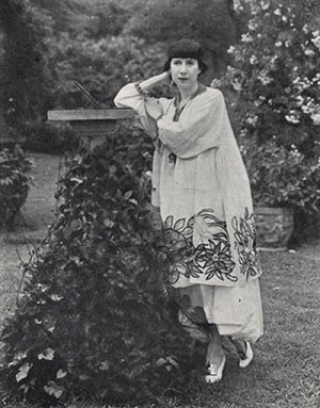Born 1871, Rochester, New York
Died 1944, New York City
Florine Stettheimer, born in Rochester to a wealthy German Jewish family and raised partly in Stuttgart and Berlin, traveled widely and was living in Munich at the onset of World War I. When she returned to New York City in 1914, she had absorbed firsthand the full scope of European historical and avant-garde art, gravitating in her own paintings toward symbolism and post-impressionism. Of her homecoming, she wrote: “Then back to New York / And skytowers had begun to grow / And front stoop houses started to go / And life became quite different.” New York / Liberty, featuring New York’s skyline, commemorated the end of the war. With its heavily impastoed Statue of Liberty, undulating American flag, and a turned wood frame designed by Stettheimer to resemble a veteran’s honor cord surmounted by a bald eagle, the painting evokes Americana handicrafts. And Stettheimer’s faux-naïf style, characterized by simplified, miniaturized forms and distorted perspective, demonstrates her rejection of the European-based academic training she received at the Art Students League in the 1890s.
At the townhouse she shared with her mother and sisters, Stettheimer hosted soirées for New York’s artistic and literary avant-garde—including Marcel Duchamp, Carl Van Vechten, Henry McBride, Gaston Lachaise, Elie Nadelman, and Alfred Stieglitz. These gatherings, and portraits of its participants, became her main subjects. Father Hoff exemplifies her propensity to surround sitters with personalized symbols; here, calla lilies and the ocean represent the priest’s love of gardening and swimming. Enclosed in a retable-like structure and posed stiffly, Father Hoff resembles the wooden retablos painted by Marsden Hartley, who admired this portrait.
Though Stettheimer was a central figure in New York’s art scene in the early twentieth century, she only had one solo show during her lifetime, at Knoedler Gallery in 1916. Despite numerous invitations to exhibit her work, she reserved her intimate paintings for a close circle of family and friends, thus remaining outside mainstream narratives of modern art.
Antonia Pocock
Bloemink, Barbara J. The Life and Art of Florine Stettheimer. New Haven: Yale University Press, 1995.
Mcbride, Henry. Florine Stettheimer. New York: The Museum of Modern Art, 1946.
Sussman, Elizabeth. Florine Stettheimer: Manhattan Fantastica. New York: Whitney Museum of American Art, 1995.
